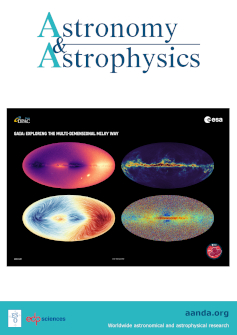Eddington ratios of dust-obscured quasars at z ≲ 1: Evidence supporting dust-obscured quasars as young quasars
IF 5.4
2区 物理与天体物理
Q1 ASTRONOMY & ASTROPHYSICS
引用次数: 0
Abstract
Dust-obscured quasars have been suspected of being the intermediate-stage galaxies between merger-driven star-forming galaxies and unobscured quasars. This merger-driven galaxy evolution scenario suggests that dust-obscured quasars exhibit higher Eddington ratios (λEdd) than those of unobscured quasars. However, their high dust obscuration poses challenges to accurately measuring their λEdd using commonly employed bolometric luminosity (Lbol) and black hole mass (MBH) estimators based on the ultraviolet or optical luminosity. Recently, new estimators for Lbol and MBH based on mid-infrared continuum luminosity (LMIR) were established, which are less affected by dust obscuration. These estimators enable the study of a large number of dust-obscured quasars across a wide redshift range. In this study, we measure the λEdd values of 30 dust-obscured quasars at z ≲ 1, the largest sample size to date, using the LMIR-based Lbol and MBH estimators. Our findings reveal that dust-obscured quasars exhibit significantly higher λEdd values compared to unobscured quasars. Moreover, we confirm that the enhanced λEdd values of dust-obscured quasars maintain consistency across the redshift span of 0 to 1. Our results strongly support the picture that dust-obscured quasars are in an earlier stage than unobscured quasars on the merger-driven galaxy evolutionary track.z ≲ 1尘埃遮挡类星体的埃丁顿比率:支持尘埃遮挡类星体为年轻类星体的证据
尘埃遮挡类星体被怀疑是介于合并驱动的恒星形成星系和未遮挡类星体之间的中间阶段星系。这种合并驱动的星系演化情景表明,尘埃遮挡类星体比未遮挡类星体表现出更高的爱丁顿比(λEdd)。然而,它们的高尘埃遮蔽率给使用基于紫外或光学光度的常用测电光度(Lbol)和黑洞质量(MBH)估算器精确测量它们的λEdd带来了挑战。最近,根据中红外连续光度(LMIR)建立了新的 Lbol 和 MBH 估算器,这种估算器受尘埃遮挡的影响较小。通过这些估计值,我们可以在很宽的红移范围内研究大量被尘埃遮挡的类星体。在这项研究中,我们使用基于 LMIR 的 Lbol 和 MBH 估算器,测量了 z ≲ 1 时 30 颗尘埃遮挡类星体的 λEdd 值,这是迄今为止最大的样本量。我们的研究结果表明,与未受尘埃遮挡的类星体相比,受尘埃遮挡的类星体表现出明显更高的λEdd值。此外,我们还证实,尘埃遮挡类星体增强的 λEdd 值在 0 到 1 的红移跨度内保持一致。我们的结果有力地支持了这样一种观点,即在星系合并驱动的演化轨道上,尘埃遮挡类星体比未遮挡类星体处于更早的阶段。
本文章由计算机程序翻译,如有差异,请以英文原文为准。
求助全文
约1分钟内获得全文
求助全文
来源期刊

Astronomy & Astrophysics
地学天文-天文与天体物理
CiteScore
10.20
自引率
27.70%
发文量
2105
审稿时长
1-2 weeks
期刊介绍:
Astronomy & Astrophysics is an international Journal that publishes papers on all aspects of astronomy and astrophysics (theoretical, observational, and instrumental) independently of the techniques used to obtain the results.
 求助内容:
求助内容: 应助结果提醒方式:
应助结果提醒方式:


